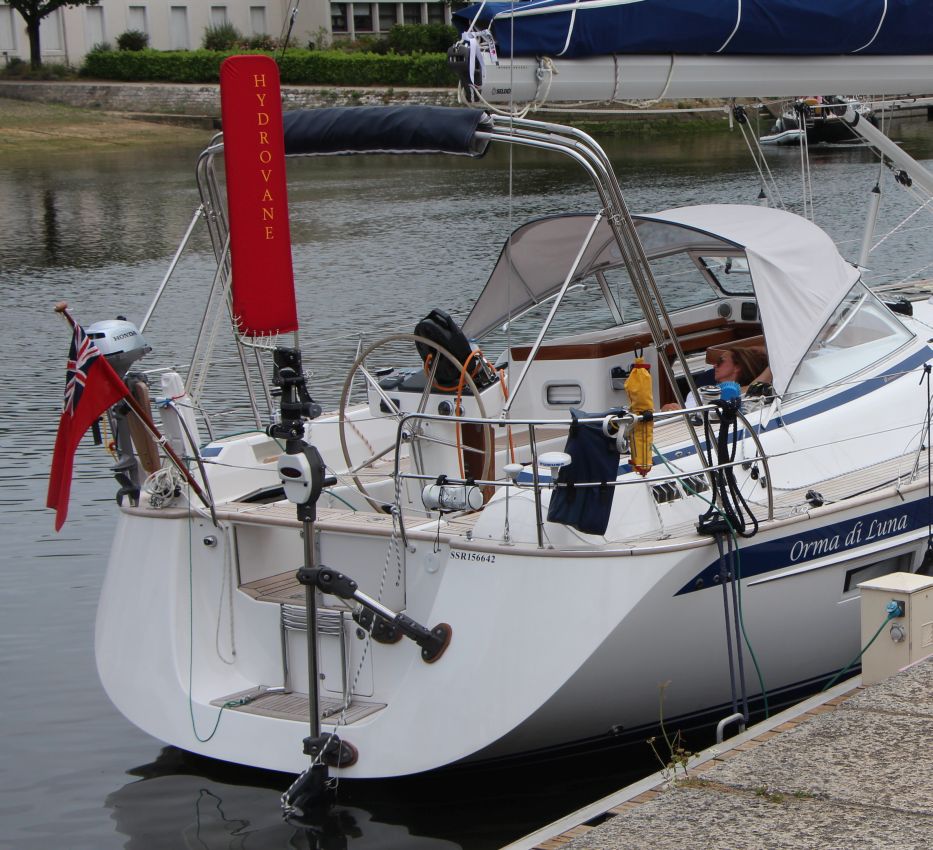 Hallberg Rassy 412
Hallberg Rassy 412
“[Helga’s] ability to sail the boat smoothly and quickly astonished me even after reading various reviews before we purchased. My wife is a bit prone to seasickness and we clearly notice the difference as soon as Helga is engaged or dis-engaged.”
From: Peter Bamford
To: John Curry
Subject: FW: Hallberg Rassy 412
Date: 22 Jun 2014
John, having used our Hydrovane (nicknamed ‘Helga”!) on and off for a couple of weeks I thought I would send you some reflections.
Overall when Helga is working she is amazing. Her ability to sail the boat smoothly and quickly astonished me even after reading various reviews before we purchased. My wife is a bit prone to seasickness and we clearly notice the difference as soon as Helga is engaged or dis-engaged. Shen even managed to steer the boat well when motorsailing on number of occasions. However, there are number of points worth mentioning or discussing:
- We had to fit Helga slightly off centre on the starboard side. We do have a bimini and a backstay where the main elements of the bridle and blocks are on the port side. The impact is that on starboard tack Helga works almost faultlessly on any point of sailing but really struggles to find clear air on port tack with the apparent wind forward of the beam. Obviously the heeling angle of the boat effectively lowers Helga further into the wind shadow. Given that we have few options with the bimini and backstay – please see photo – I’m not sure whether there any easy answers to this. I would welcome your thoughts.
- On our boat the normal genoa is low footed with minimal overlap but we do carry and use a ‘code zero’ sail in up to around 12/13 knots of wind with the true wind more than 55/60 degrees off the nose. The balance of boat is much more sensitive to changes in wind strength with this sail up and Helga needs a bit more adjustment as we go along.
- I also note your comments about removing the rudder for maneuvering in marinas. We have found this to be absolutely essential, particularly since our boat is fitted with a sail drive well forward rather than a traditional propeller. With Helga’s rudder locked centre it is absolutely impossible to get any side ways kick on the stern when driving on to pontoons. We had a couple of quite embarrassing moments until I realized what the issue was!
- Please could you send me a couple of spare pins? I’ve read your comments about rotating the pins to prevent fatigue failures. I’d like keep two spare.
Regards,
Peter
Editor’s note: John’s response to Peter’s questions:- DIRTY AIR – You might be surprised to hear that we have never had a report of dirty air affecting performance when beating … although such is certainly possible/understandable. Part of the reason is that cruisers so rarely have to beat upwind and that is such an easy point of sail steering wise. If you ever do get in that situation again you can try:
- Shift the sheeting to the traveler (if you have one)
- Slack the main sheet a bit
- Put a reef in the mainsail
- There is an expression: ‘Gentlemen never go to weather’.
- HEADSAILS – If you have a true genoa with a low foot I always recommend having them recut to put the clew higher making the length of the sides more like an isosceles triangle so you can see beneath it and when you slack its sheet the sail doesn’t simply open at the top. Genoas are one purpose sails – meant to go upwind – a direction that cruisers try hard to avoid. When off the wind, even with the headsail on the leeward side it is often wise to put a pole on the clew to tighten up the sail – keep it from collapsing and filling. That collapsing and filling corrupts the boat balance sending confusing signals to the HV.
- RUDDER REMOVAL – For arrival in a marina it is much preferable to remove the rudder … unless you have an extra pair of hands to use the HV rudder – two rudders are better than one.

